While choosing a kayak paddle may seem as easy as acquiring something with two blades to propel you through the water, there is a little more to it.
Kayakers take thousands of strokes every hour. Having the correct information to help you choose the best kayak paddle is key because if your gear doesn’t suit you, it will likely end up in the corner of the garage growing dusty with disuse. From kayak paddle sizing to construction materials, here is what you need to know to help you choose the best kayak paddle.
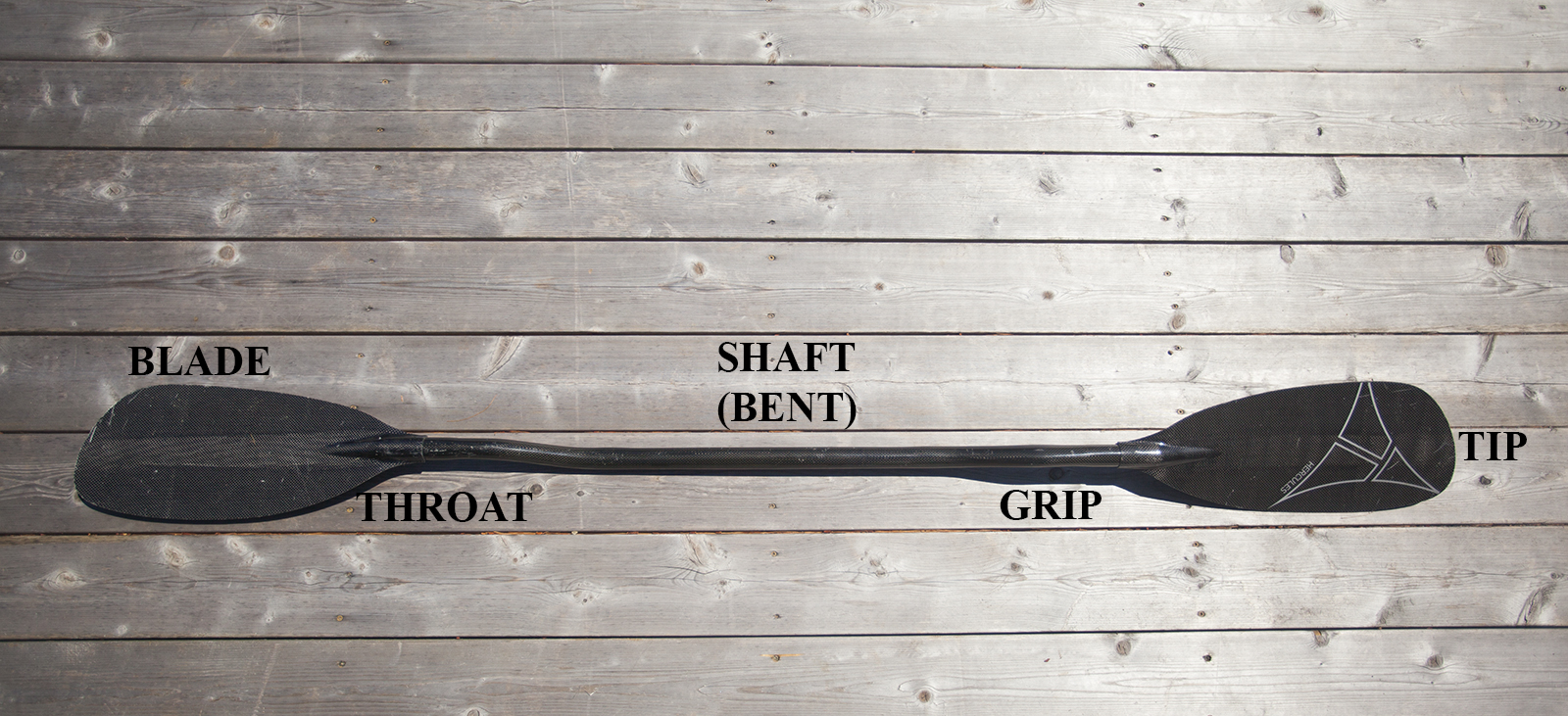
Different kayak paddle blade shapes
The shape of your paddle blade is crucially important as it determines how your paddle interacts with the water during each stroke. The kind of paddling you want to do will determine the appropriate blade shape.
High angle paddle
If a paddle is referred to as high angle, it means that the paddle is designed to be held more vertically during a forward stroke. This means that the stroke is more powerful and can move the kayaker faster through the water.
If you are going to be racing or paddling on rough or whitewater, a high angle paddle is a good choice to give you lots of control in more challenging conditions. The blades on high angle paddles are shorter and broader. View our selection of whitewater kayak paddles in Paddling Buyer’s Guide.
Low angle paddle
Low angle paddling means that the paddle is held more horizontally and both hands are closer together in height through the stroke. This kind of paddling is less tiring and is good for consistent paddling while kayak touring.
Blades on these low angle paddles are longer and skinnier than high angle paddles. If you are going for a day trip on flatwater or a multi-day kayak tour, this is a good choice for you.
Wing-shaped blade
The wing blade is designed with one blade face with a shallow scooped shape intended to increase the efficiency and power of a forward stroke.
This is a good kayak paddle choice for racers and may be uncomfortable for the recreational paddler who prefers more mellow, low-angle strokes. To optimize the unique design of a wing shape, you need to paddle with the blade nearly vertical as it moves through the water.
Dihedral blades
If a kayak blade is described as dihedral, it means that the paddle actually has two power faces. If you hold a paddle straight out in front of you and look at the shape of the blade, a dihedral one will have two faces sloping slightly down from the middle of the blade, which is raised in the middle like a spine. The intention of this design is to minimize flutter or vibration during the stroke and allow your blade to better catch the water.
Greenland paddles
Greenland paddles look nothing like other paddles you will find on the market. The slim wooden paddles used for centuries in Greenland are narrow and shaped like an airplane propeller. They are versatile and a great choice for kayak touring.
Advocates of this style of paddle like that you can achieve a high cadence, and the natural buoyancy of the paddle can make rolling a lot easier as the paddle rises to the surface of the water. If you are paddling in super choppy water however or using a lot of quick bracing or sculling strokes, you may prefer some of the wider blades described above to provide more control.
Kayak paddle construction materials
Aluminum paddles
Aluminum paddles are the lower end of the price and quality spectrum. They are hardy and can be a good purchase if you are just getting into kayaking or need something to use once in a while. The shafts can be cold in chilly weather and due to their heavier weight would not be as enjoyable to paddle on a multi-day tour as a carbon fiber or fiberglass paddle.
Plastic paddles
Plastic paddles are quite common due to their durability and price. They don’t require very much maintenance, but you will find they weigh more than fiberglass and carbon paddles.
Plastic paddles often have comparatively thick edges and more flex, which results in a less efficient stroke. They are a good option for recreational paddlers, playing around at the cabin, short day trips or as a spare, in case you lose a paddle.
Carbon fiber kayak paddles
Carbon fiber is the most expensive and highest quality material for a kayak paddle. Carbon fiber is extremely light and also super strong and stiff, making it an excellent choice for a long kayak touring trip. The shaft will feel warmer on your hands than an aluminum paddle. See the carbon paddle selection in our Paddling Buyer’s Guide.
Fiberglass kayak paddles
Kayak paddles made of fiberglass are light, stiff and durable. They are a common choice for kayak touring and recreational paddlers. Mid-range blades often have fiberglass blades and carbon shafts, representing a compromise between weight, durability and price. Check out fiberglass paddles in our Paddling Buyer’s Guide.
Wooden paddles
Those who prefer using a wooden kayak paddle love the increased flexibility, warmth and aesthetic. Compared to the above materials, wooden paddles do need a bit of upkeep, like sanding and varnishing. They are mid-range in terms of weight and will vary in price depending on the kind of wood used.
What is feathering on a kayak paddle?
Feathering on a kayak paddle refers to the angle of the two blades. If both blades on a paddle are set at an equal angle when the blade lays flat on the ground, then the paddle is unfeathered. If the two blades are set at different angles, this means the paddle is feathered.
Feathered paddles can decrease the resistance from a headwind or tailwind while you paddle because one blade will be positioned at an angle to cut through the air while the other pushes water.
Some beginner kayakers may find basic and key skills like rolling and bracing more challenging with a feathered blade.
When a paddle is feathered, it means one hand stays in place while the other rotates along with the shaft as the paddle moves through the stroke. This helps the paddle make contact with the water at an angle that emphasizes efficiency.
If you are going to be doing a lot of kayak touring, especially in open water, a feathered paddle will be a good choice because it can make paddling easier in these conditions. If you are a recreational paddler who sticks closer to the cottage while paddling for a few hours, you may not require a feathered paddle.
One important consideration is the condition of your wrists. A feathered paddle will mean your wrist rotates more as you paddle. If you have issues with pain in your wrist, an unfeathered blade may be easier on your joints and more comfortable.
Some beginner kayakers may find basic and key skills like rolling and bracing more challenging with a feathered blade.
If your paddle is only one piece, it will be set as feathered or unfeathered without the option to adjust it. Some paddles will come with a ferrule placed on the shaft that can allow you to adjust your paddle to make it feathered or unfeathered.
Ferrules are the joints where a paddle joins together. If you have a paddle with ferrules, it means the paddle can be broken down into different sections with different options for feathering, allowing you more versatility based on what kind of paddling you are doing.
From $400 carbon paddles to $70 plastic ones, many paddles on the market at the moment offer adjustable feathering.

One-piece or two/multi-piece paddle
Paddles that have ferrules can be broken down, while those without ferrules remain in one piece.
A multi-piece paddle is great to break down and store in your kayak as a spare or to bring traveling with, but some people don’t like them as a day-to-day paddle because their structure can make them heavier and less efficient unless they are very well designed and high-end.
Ferrules can also wear down, become stiff from salty air and water or get stuck.
Bent and straight shaft kayak paddles
The majority of kayak paddles have straight shafts, but some will also have sections that are slightly bent. The intention of these bent sections is to let your wrists stay in more neutral positions while you paddle.
Although they are frequently pricier, for those who are kayaking for long distances or are prone to wrist pain and strain, a bent kayak paddle shaft can be a worthy investment.
It is personal preference, but some kayakers may not like bent shafts while kayaking because they feel it makes important maneuvers like braces unnatural. If you are unsure, try to get out on the water and try both before committing to a shaft design.
Kayak paddle sizing for you
Once you have decided on the best paddle for you, it’s time to determine the proper size for the best performance and comfort on the water.
You may have your eye on a beautiful and expensive bent-shaft carbon paddle, but if you buy it in the wrong size and it hurts your shoulders and wrists, it’s not worth much to you. Here is what else you need to consider to buy the correct size kayak paddle.
Different styles of paddling often call for different paddle lengths.
Not all kayaks are made the same. Depending on what kind of paddling a kayak is designed for, it will vary in width. For example, recreational kayaks are designed to be stable and so are often built wide, while touring kayaks are longer and narrower for more speed on lengthy trips.
A paddle that is a great fit for you while paddling a wide recreational kayak for an hour may not be as comfortable to paddle on a week-long sea kayaking tour.
Kayak paddle size chart
Given the position we are in while kayaking, the length of your torso is an important detail when sizing a kayak paddle. To measure correctly, sit down in a straight-backed chair and use a measuring tape or stick to determine the distance between the seat and your nose. The below charts from our friends at Aqua-Bound show appropriate paddle lengths based on your height and kayak width.
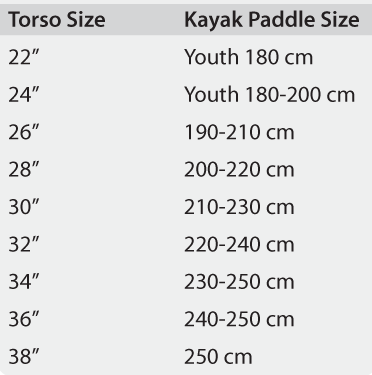

If you are already on the water with a paddle, a method we like is to hold your paddle out in front of you and make sure your arms are bent at 90-degree angles. If your hands fall around two-thirds from the middle of the shaft to where the shaft and blade meet, the paddle is a good size for you.
Different styles of paddling often call for different paddle lengths. If you are going to be racing, playboating or running rapids, something on the shorter side will allow you to take shorter and faster strokes.
If at all possible, take a potential paddle out on the water or at least try one of a similar size. You can get great advice in-store and do all your research, but the most important factor in your paddle purchase should be how it feels as you paddle.
A sea kayaker on glassy water. | Feature Photo: Flickr user Roger Nilsson




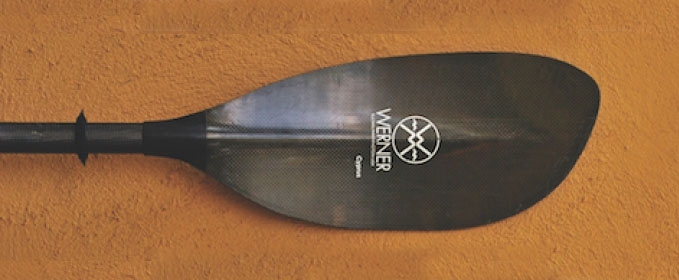
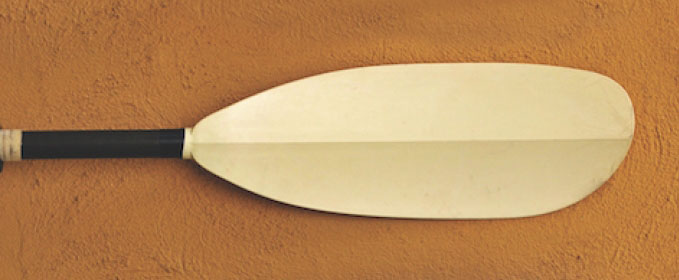



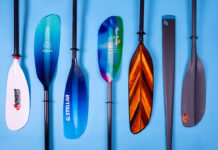


Our family is planning to take a vacation and do outdoor extreme activities this weekend. I love that you were able to differentiate the different types of kayak paddles in your article as well as their usage. Moreover, I think we need to buy the bent shaft kayak paddle for our children so that they will enjoy the activity and it is a worthy investment.